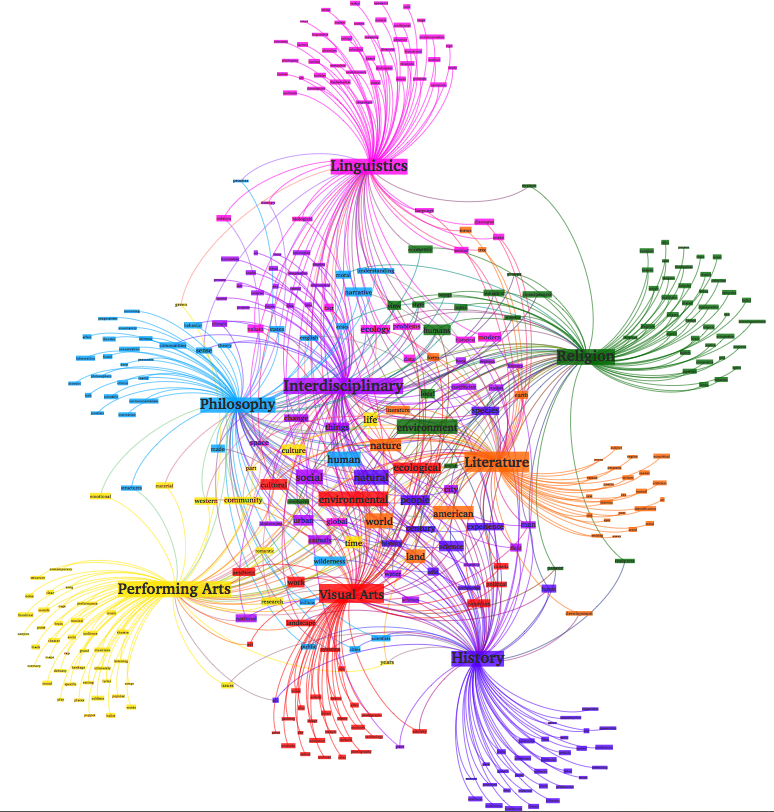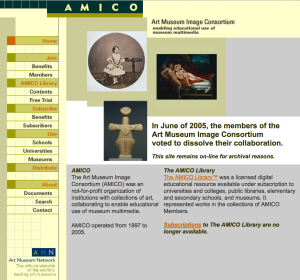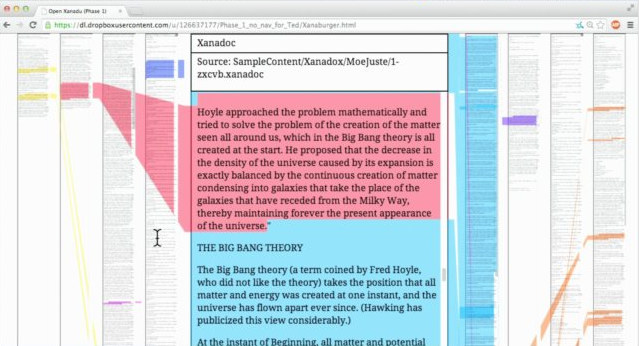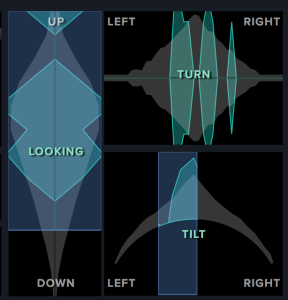Veronica Poplawski has posted a nice blog essay on Topic Modeling and Gephi: A Work in Progress : Digital Environmental Humanities. She walks through a project she did on 358 Environmental Humanities documents related to a workshop I was part of in the Fall (see my conference report here.) First she used Mallet to generate topics and then she created an XML file to bring the topics and associated words into Gephi for visualization. Nice work!
Weaponizing the Digital Humanities
Jan Christoph Meister has posted a blog about Weaponizing the Digital Humanities. His entry comes from an exchange we had, first around the paper about stylistics to psychologically profile people. (See my conference report on DH2014.) After the session we ended up talking with someone probably from the intelligence community. It is a bit startling to realize that we merit attention, if that is what it is. Certainly research on recognition of typing patterns might be of interest, but it is hard to imagine what else would be of interest.
The other side of intelligence interest in our field is our interest in surveillance. What can we learn from the intelligence agencies and the techniques they develop? I’m certainly intrigued by what they might have been able to do. What responsibilities do we have to engage the ethical and interpretative issues raised by Snowden’s revelations. My blog entry Interpreting the CSEC Presentation: Watch Out Olympians in the House! would be a attempt to interpret Snowden documents – perhaps paleography of the documents.
Meister rightly opens the ethical issue of whether our organization should have a code of ethics that touches on how our research is used. We have a code of conduct, should it extend to issues of surveillance? The humanist in me asks how other fields in the humanities have dealt with the sudden military application of their research. There was/is an issue around the involvement of anthropologists and sociologists in Petagon-funded projects.
The Amiga Lounge
From Slashdot I came across a site on the Amiga called the The Amiga Lounge. On the site they have a story on The Almost forgotten Story of the Amiga 2000. The 2000 isn’t a favorite for collection, but it was the machine that took the Video Toaster card which made video editing and effects possible on the Amiga before other personal computers.
My Very Own Voyant Workshop
Stéfan Sinclair and I just finished a workshop on My Very Own Voyant. The workshop focused on how to run VoyantServer on your local machine. This allows you to run Voyant locally. There are all sorts of reasons to run locally:
- It runs faster
- You can upload large texts faster
- It can process larger text corpora
- You can control the server
- You can keep your corpora confidential
You can download VoyantServer and read instructions here.
AMICO dissolved
I just discovered (about 9 years after the fact) that The Art Museum Image Consortium (AMICO) was dissolved in 2005. For a while AMICO seemed to be one of the major art historical image banks for teaching and research. Now they are gone, though they have kept a web site for archival purposes (see screenshot of entry web page above.)
I have written before about digital centres that have closed down, AMICO isn’t an example of a centre, but it was an important project which is now gone. I can’t find any discussion about the dissolution, but will look. In general, I think we need to learn from the passing of projects.
Scopeware Vision Professional
I was reading about the Yale Lifestreams project which may have been one of the first life-tracking projects. Lifestreams was developed by Eric Freeman (it was his 1997 PhD project) and David Gelernter. They had some interesting ideas about how the computer should organize your data into streams rather than you having to file stuff. The streams could take advantage of the flow of your life. Here is how lifestream is defined:
A lifestream is a time-ordered stream of documents that functions as a diary of your electronic life; every document you create and every document other people send you is stored in your lifestream.
Freeman and Gelernter tried to commercialize the ideas through Scopeware released by Mirror Worlds. If you search Google Images for Scopeware you can see a number of screenshots that give an idea of how the interface organized files into streams.
Many of their interface ideas seem to have reappeared in things like Apple’s Cover Flow and Time Machine which explains why Mirror Worlds sued Apple (unseccessfully).
The idea is supposed to have come from Gelernter’s semi-philosophical book Mirror Worlds: Or the Day Software Puts the Universe in a Shoebox…How It Will Happen and What It Will Mean (1991) in which he reflects on the change from small personal software to large networked software that “mirrors” the world. Google Street View and all the virtual surrogates available on the web would seem to prove him right, though he may have been imagining more of a VR type implementation. (Admission: I haven’t read the book, just reviews.)
What intrigues me is the focus on time and the move away from representations of time as a line that traverses from left to right. In streams you are in time and can swim back like driving down a road to the past.
YOU: A Novel
I recently finished the science fiction novel YOU: A Novel by Austin Grossman. The novel is about Russell’s returning to get a job with Black Arts a game development studio. Russell distanced himself from his high-school friends with whom he got into designing a role-playing computer game. After dropping out of the liberal arts to law trajectory he had been on, he goes back and gets a job with the company his friends had created in the meantime. Grossman has worked in game design, so the book has an authentic feel. It is also good on how franchises are maintained as the story turns around the creation of yet another sequel to a tired franchise with flashbacks to when they created the other versions. There are a number of interesting ideas and enigmas to YOU including:
- YOU is about the dream of the ultimate game. The book starts and ends with the question of the ultimate game and how the imagining of that game is so important to gaming,
Finally, there is the secret of the ultimate game, inscribed on a series of crumbling scrolls in a language that is no longer well understood. But partial translations suggest that the secret of the ultimate game is that you’re already in the ultimate game, all the time, forever. That the secret of the ultimate game is that the ultimate game is a paradox, because there’s no way to play a game without knowing you’re playing it. That games are already awesome, or else why are we making such a fuss? (p. 365)
- Part of the issue of the ultimate game is the drive to greater realism as if graphical realism were the only metric. The novel forces us to ask what is realism and whether better graphics are necessarily more immersive (compared with better stories or more open worlds.)
- Simon, the genius behind the game engine of Black Arts dies before the beginning of the novelistic present in an elevator. It isn’t clear how he died, but it seems relevant at the beginning of the novel. Grossman answered questions about the novel here including an answer about how Simon’s death is a “bait-and-switch.”
- Finally, there is a really interesting reference to the story of love told in Plato’s Symposium that men and women are separated and want to join up again,
To forestall any future threat, the gods decreed we should each be separated into halves, and each half hurled into a separate dimension. There was the human half, weak but endowed with thought and feeling, and the video game half, with glowing and immortal bodies that were mere empty shells lacking wills of their own. We became a fallen race and forgot our origins, but something in us longed to be whole again. And so we invented the video game, the apparatus that bridged the realms and joined us with tour other selves again, through the sacred medium of the video game controller. The first devinces were primititive, but every year the technology improved, and we say and heard and sensed the other world more clearly. Soon enough we’d be able to feel and smell and taste and live entirely in our own bodies again. And on that day, he finished portentously, we’d challenge the gods once more.
“First of all,” I said, “you ripped that whole thing off from that story in Plato. …” (p. 301)
Xanadu Released
Hacker Trips has an article about how Ted Nelson’s Xanadu finally gets released after 51 years (with Transclusion). The article describes a conference in Ted Nelson’s honour. At the end he is quoted to the effect,
To wind up his story, Ted Nelson stated that he was “dealt one of the best hands in history, and misplayed it to the hilt. [He] could have accomplished so much more. [He] was here 1st, and it’s all gone wrong. [He] believes this would be a very different world and better world if [he] had gotten leverage. The world has gone the wrong way.”
Nelson also announced a demo of a working version of Xanadu with transclusion. Open Xanadu is up at the Xanadu site.
Selfiexploratory
Stan pointed me to a net site called Selfiexploratory where you can explore selfies with a very neat faceted browsing control panel. The panel lets you restrict the selfies to those where the person looks up or down; or the head is tilted. You can thus explore the database of selfies by pose and other categories.
CSDH-SCHN 2014 Conference
I have posted my CSDH-SCHN 2014 conference notes now that the conference is over. I will probably put up some notes on CGSA 2014 also in there tomorrow. We had great participation this year. You can see the conference programme here. One thing that went well is the Digital Demonstration session which was like a poster session, but with demos of neat tools and digital projects. Some themes:
- Visualization and text mining
- Topic modelling and mallet (see theme immediately above)
- This moment in digital humanities in Canada
- Studying the history of our disciplines
- Connecting with the other humanities disciplines and organizations like Compute Canada





